Physical Tour
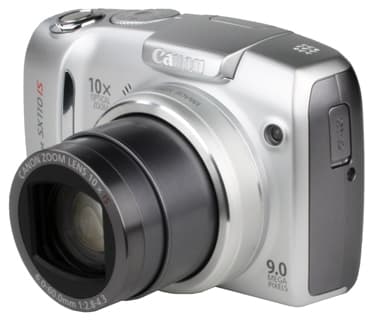
Front(7.50)
There's a slightly raised area on the left of the front, bordered by a sliver of silver plastic, which acts as a hand grip. The lens is permanently slightly projected by about a half-inch, but this is substantially less than you'll see in most other ultra-zooms. Above the lens is the flash, which has to be manually raised and lowered, and to its right is the auto focus assist lamp.
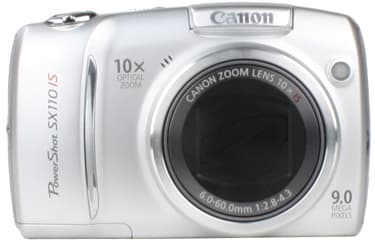
The area to the left projects slightly as a grip.
Back*(7.75)*
The rear of the camera has the LCD flush against the left side, with a small button directly above the top left corner, which can be customized to a number of shooting functions, and is used for printing while in Playback mode. To the right of the screen is the primary method of navigating menus, a control wheel. This interface will be familiar to iPod users, as it's a dial with four buttons integrated in the four directions, with a button in the center used for accessing a quick menu or okaying options. Below it are two curved buttons, one for altering the displaying settings, the other for accessing the menu. Similar buttons above the control wheel change face detection settings and exposure compensation. Finally, there's the Playback button, which triggers its namesake mode.
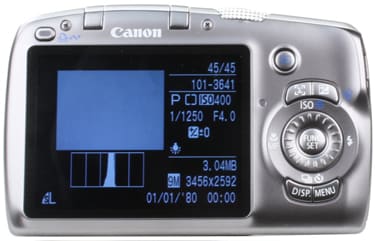
The buttons are all distinctively shaped, which helps you differentiate by feel.
Left Side* (7.00) *The left side is mostly blank. There's a small panel that can be loosened, which houses the internal battery, used to maintain date and time information.

The left side is mostly bare.**
The right side has a small silver tunnel for the lanyard loop, and above that the thin cover for the USB and DC inputs.
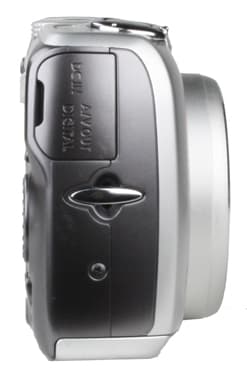
*The right side houses the ports.
*
On the far left of the top is a cluster of holes covering the speaker, then the flash. To the right of that is the mode dial, which projects slightly out from the back of the camera to make it easy to adjust. The shutter control and zoom are placed slightly forward, directly above the enlarged grip, and to their rear is the ever important power button.
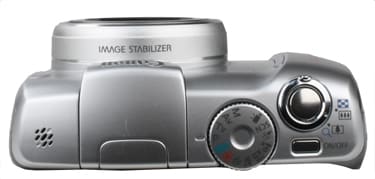
The flash is manually raised and lowered.
The PowerShot's bottom offers a tripod mount that feels a bit fragile, and the door to the compartment housing the AA batteries and memory card slot.
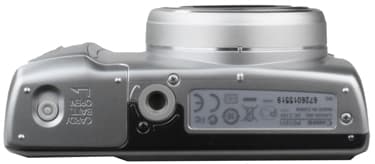
The tripod mount doesn't seem particularly resilient.
Color and Resolution
We attempt to test all camera's to their limits, and the Canon PowerShot SX110 IS is no exception. In general it scored average to below average in these tests, and really struggled with white balance and noise. On the positive side, it maintained Canon's legacy of excellent color accuracy, and did very well in video mode.
**Color ***(11.15)*
The first test of our gamut is color accuracy. What we look for in this trial is how closely the camera can recreate the actual colors found in a scene. While having ultra-bright and over-saturated pictures may make them look dynamic, it's not actually what you were looking for. To test how accurately the SX110 IS can capture images, we shoot the industry standard GretagMacbeth color chart at the ample illumination of 1700 lux. We take the resulting images and run them through Imatest, an image analysis program, which tell sus how close to the known chart value the camera's recorded image appears. In the chart below, you can see the results at a glance, with the outer colored rectangle representing the captured value, the inner area the chart color corrected for luminance, and the inset rectangle the original chart color.
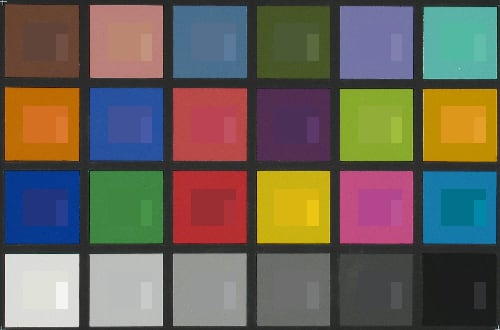
*Greens and some blues were recorded very accurately
*
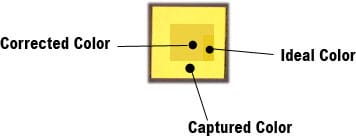
These results can be expressed in another manner, in the chart below. In this one, the ideal color is represented in the square, and the captured color in the circle, with the difference shown as the direction and length of the line.
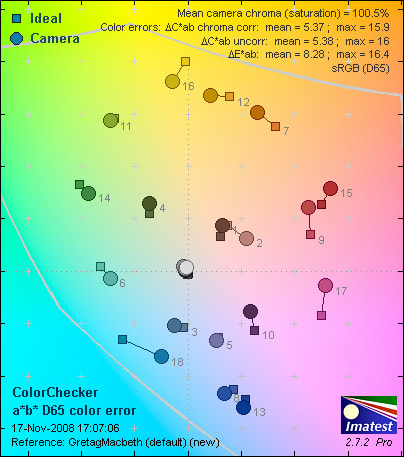
*The SX110 IS struggled a little with cyan and magenta
but did very well otherwise.
*
Canon cameras are known for having excellent color reproduction, as you can see in these charts. Not only that, but the saturation is close to 100%, which means your pictures won't come out gray and boring, or over the top and bombastic. This is an excellent color score, in line with or superior to what we've seen with other ultra-zooms we've reviewed (as shown below), and from the Canon brand in general.
Canon PowerShot SX110 IS Color Scores
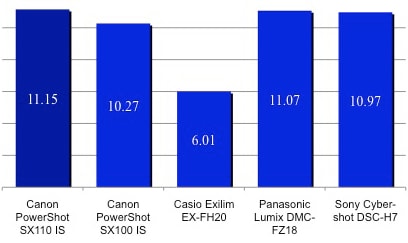
Resolution*(6.90)*
There's more to resolution than just megapixels: it's the total camera system of sensor, optics, digital processing and so on that determines how sharp your final photo looks, not that highly touted megapixel statistic. We test for resolution by shooting an industry standard chart, and running the images through Imatest, which reveals the actual resolution in line widths per pixel height, a measure of alternating black and white lines across a single area.
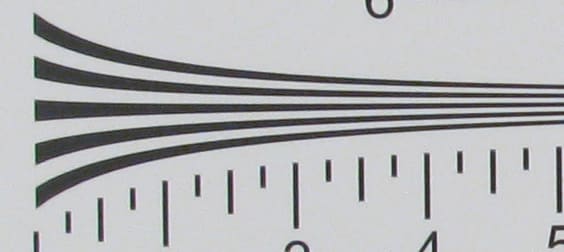
A section of the industry-standard resolution chart that we use for testing
The PowerShot SX110 IS captured 1509 lw/ph horizontally with minor over-sharpening, and 1620 lw/ph with some under-sharpening vertically. While not an amazing score, it's about average for this type of camera (as you can see in the comparisons below); this mediocre performance seems to be the price of having such a large zoom ratio.
Canon PowerShot SX110 IS Resolution Scores
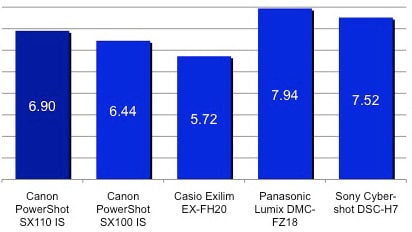
Dynamic Range*(5.11)*
A camera's dynamic range is a measure of its ability to properly expose images that have a wide range of levels of brightness at once. For instance, if you're taking a photograph of someone who is under a tree on a sunny day, a camera with a poor dynamic range may cause one extreme or the other to come out gray, while a wider dynamic range will keep everything exposed properly. To check how the camera can handle this range of illumination, we shoot a backlit Stouffer chart, which has a series of 40 tabs, running from white to black, and we use Imatest to see how well the SX110 IS performed at every ISO.

Apart from being a beautiful curve, the graph above shows how dynamic range steadily drops off as ISO sensitivity increases. Unfortunately, by the time you hit the higher ISOs, the SX110 IS really struggles to get a decent dynamic range. It's not a horrendous performance by the Canon, but it's a bit worse than the cameras we're comparing it to.
Canon PowerShot SX110 IS Dynamic Range Scores
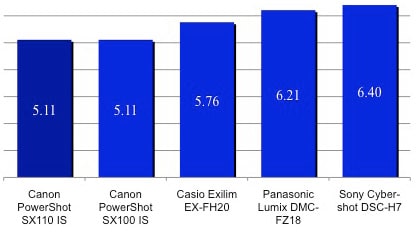
White Balance*(5.85)*
There are certain phenomena which are very easy for a human brain to deal with, but much more difficult for a computer chip to try and understand. One of these is the way different sources of light provide a different color cast over objects the objects they illuminate. Our brains can automatically compensate for this, and say 'even though this sheet of paper is under an incandescent bulb, and looks slightly yellow, it's actually white.' Cameras, on the other hand, have to try and deal with these color problems using a feature called white balance. We test how well they handle the challenge by photographing a color chart under a number of different light sources using both the camera's automatic adjustment setting and manual presets. In the examples below the differences have been exaggerated to make the color shift clear; you will not see this much of a discrepancy in real life.
With white balance set to automatic, we photographed with the flash, under fluorescent and tungsten bulbs, and in indirect daylight. The PowerShot SX110IS struggled with every setting, except the flash. All three other sources of illumination appeared to baffle the Canon, resulting in a poor score for this test.
-
**Preset (5.72)
*Unfortunately, the camera fared no better using presets for the light types (barring flash due to lack of a preset for that feature). While it did perform much better in indirect sunlight, white balance actually came in worse under the fluorescent and tungsten lights. Once again, not a good result.
Unfortunately, the SX110IS did poorly with both presets and on automatic mode. Luckily, the camera does allow you to set a white balance manually, by shooting a neutral card under current lighting conditions, which might prove helpful if you are concerned about keeping your colors as close to real-life as possible.
Canon PowerShot SX110 IS White Balance Scores
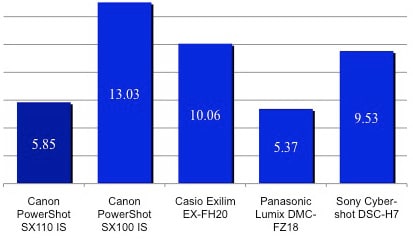
Noise and Video
**Noise
**Image noise is one of those sadly unavoidable facets of photography. It appears most as you ratchet up the ISO; increased light sensitivity brings with it the visual static that disfigures your photos. You'll notice it across wide areas of a single color, and it looks like speckling across the picture. We test noise levels at the full range of manual ISOs, as well the camera's automatic ISO setting.
Noise – Manual ISO*(6.27)*
In the graph below, noise levels increase along with ISO levels as expected. Noise stays mostly at a reasonable levels up to ISO 800, which is probably due to some degree of automatic noise reduction processing, and then skyrockets at ISO 1600. While using this camera, as long as you stay at ISO 800 or below, you probably won't have too much trouble with image noise, but that jump at 1600 is telling. Stay away from the highest setting whenever possible.
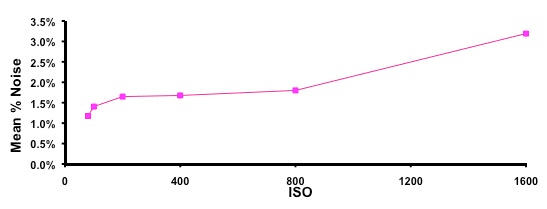
As you can see in the comparisons chart, this is a slightly below-average performance for SX110, once again, mostly due to that major noise jump at the top ISO setting.
Canon PowerShot SX110 IS Manual Noise Scores
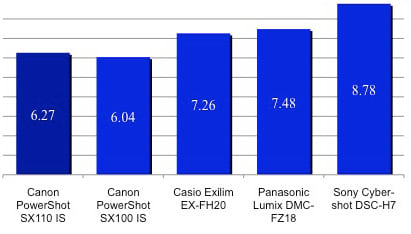
The SX110 IS certainly isn't the only camera we've had that's done abysmally on the auto noise test, but it's still pretty bad. In this test we set the camera on automatic ISO, and let it decide what's the best ISO for shooting our well lit chart. The Canon decided that ISO 200 was the right level to shoot at, a bit higher than you'd want for a brightly lit chart. Combined with an overall disappointing noise profile, this produced a very low score.
Canon PowerShot SX110 IS Auto Noise Scores
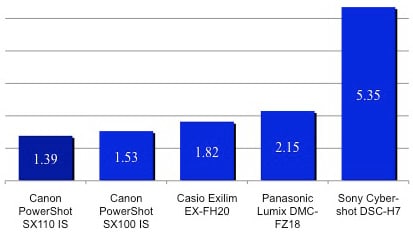
**Low Light ***(6.91)*
Our low light trials are run as two tests, the first under decreasing light levels, the second using long exposure under fixed illumination. The former is shot under four levels of illumination: 60 lux (about standard indoor nighttime illumination) down to 5 lux (about the light of a single candle in a dark room). We test for color accuracy, noise levels and saturation, much as we do with our color accuracy test. The Canon kept relatively good color accuracy across all the light levels, especially at 60 and 5 lux, as well as repressing noise levels down to 2.5% or below. However, the pictures had a tendency to come out under-saturated.
The second half of the test is shooting long exposures, once again using the GretagMacbeth color chart to look at color accuracy, saturation and noise levels. We shoot at sub-30 lux illumination for 1, 5, 10 and 15 seconds, which is the maximum exposure length afforded by the SX110 IS. As you can see below, the noise level stays pretty consistent across all the exposure times, and saturation floated at slightly above 100% for all of the photographs. Color accuracy was a bit worse than we would have liked for this test, straying surprisingly far from the levels we saw in the low light portion of the test.
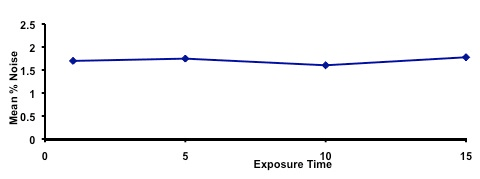
Yet again, an average result from this Canon ultra-zoom. It managed to outperform the Casio and Panasonic we're comparing it to, but it really struggled against the older Canon, and the Sony Cyber-shot DSC-H7.
Canon PowerShot-SX110 IS Low Light Scores
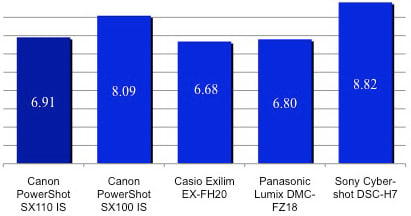
Still Life
To demonstrate the effect of shooting at different ISOs, here are two series of photographs taken at every ISO available for the SX110 IS, under fluorescent lighting, with exposure setting to automatic. Click on the image to see a full-sized version, but be aware that this may take a significant amount of time to load because of the large size.
**Video Performance ***(7.23)*
One of the handy advantages to a point-and-shoot camera is its ability to record video as well as photos, so we would be remiss in our reviewerly duties if we did not test these facilities with the same rigor as we bring to shooting still images.
Bright Indoor Light - *3000 Lux
The first of our tests uses the now-familiar color accuracy module of Imatest, under the glare of 3000-lux illumination. The chart below shows that the SX110 IS did very well with greens and oranges, but struggled a bit with cyan and magenta. Overall, though, the color came out quite accurately, with close to ideal saturation.
*
****

**
*
Low Light - *30 Lux
Next, we ran the same test under the decidedly less ideal 30 lux, which naturally caused a few more problems. The cyan and magenta values were even further off than under bright light, and there was more trouble with oranges and blues. Regardless, this is actually a fantastic color score for such low light conditions. It was accompanied by noise levels of approximately 2%, which isn't out of the ordinary for a point-and-shoot recording video under such a low light level.
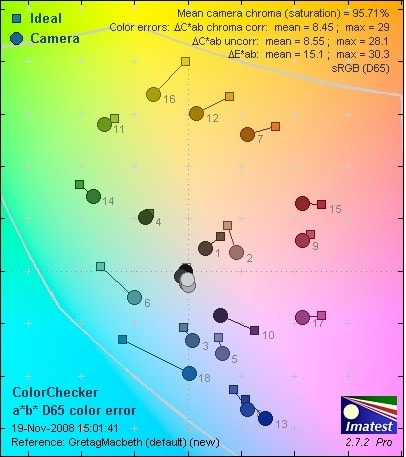
*****Resolution ***(1.44)*
The Canon did poorly in this area, pulling down its overall video score, as it only captured 294 lw/ph vertically and 490 lw/ph horizontally. A score like this indicates that your videos will look blurry, even though the color will be excellent.
**Motion ***(1.00)*
Disregarding the resolution troubles, the SX110 IS was able to capture motion quite well, without scan lines or blowing out areas of bright color in moving objects. This leads to the Canon having a very good overall score for video.
Canon PowerShot SX110 IS Video Scores
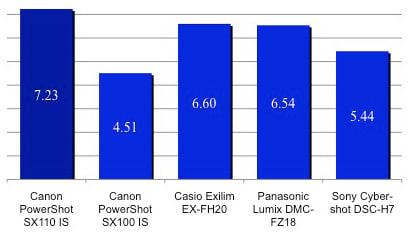
Speed and Timing
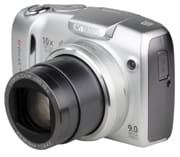
**Speed/Timing
**As much as we'd love all cameras to be so blisteringly fast that you would never miss a shot while waiting for a camera to start up, this isn't the case. So, to test just how quickly you can expect the Canon PowerShot SX110 IS to respond, we've run it through a number of speed tests, always using a high-speed memory card to minimize data transfer bottlenecks.
**
Startup to First Shot ***(7.20)*
The camera took on average 2.8 seconds to start up, a relatively sluggish period, but not the worst we've encountered. Ultra-zoom cameras have a tendency to wake up slowly.
**
Shot-to-Shot ***(9.23)*
At full resolution, the PowerShot took 1.3 frames per second, a respectable enough result. This isn't as fast as the speed-demon Casio EX-FH20, which blazes away at 40 frames per second, but it's competitive with most ultra-zooms on the market.
**
Shutter-Shot***(2.32)*
This test measures how quickly the camera can autofocus and then take the picture. The Canon was unfortunately slow on this test, taking approximately 0.8 seconds to perform the allotted task.**
Processing***(7.03)*
Our final timing test looks at the delay between taking a photo, and an image appearing on the LCD for review, indicating the amount of time required for the camera to process the image data. The Canon took approximately 1.2 seconds, which is a tiny bit on the slow side, but not untenable.
Components
Viewfinder*(0.00)*
As with many point-and-shoots, the Canon PowerShot SX110 IS lacks a viewfinder.
LCD Screen(6.00)
The Canon's LCD packs a modest 230,000 pixels into its three-inches of real estate. It's bright, clear and suffers under only minimal solarization. The screen can be set to five levels of brightness, but there's no function to automatically adjust the level according to ambient light, as is found in some other cameras. Hitting the Disp. button while shooting can show or hide all the information scattered around the edges of the screen, like ISO, white balance, metering and other such useful bits of info. A histogram would have been useful, but most buyers of this type of camera probaby won't miss it. The live view kept up with motion and repositioning the camera well most of the time, except under very low light, where there was a noticeable lag.
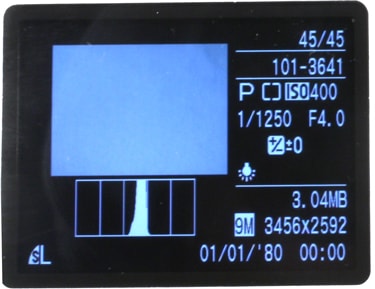
The LCD is run-of-the-mill*
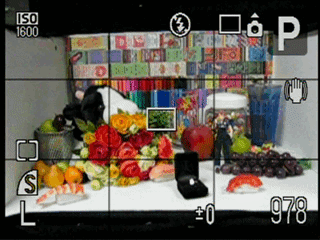
The effect of pressing Display while shooting

The effect of pressing Display while in playback
**
Flash*(7.50)
*The flash is a bit of throwback hardware, as it has to be manually raised and lowered. This is a little awkward, but it does prevent the flash from firing automatically when you don't want it to. Canon rates the flash output 1.6 feet (50cm) to 9.8 feet (3m) zoomed all the way out, and 3.3 feet (1m) to 6.6 feet (2m) at full telephoto. We noticed there was some significant light dropoff towards the edges of the frame while using the flash.
The controls offered on the flash are quite inclusive. While it's deployed, you can set it to automatic or manual. In automatic, you can adjust the flash exposure compensation ±2 levels in 1/3 steps, or if you flick it on manual, you can chose one of three levels of brightness. There are two methods for reducing red-eye, either by firing the flash twice, or else by using the auto focus assist lamp first. The slow synchro option is a setting designed for use with slightly longer shutter speeds that helps light both the foreground and background, and finally there's Safety FE, which adjusts aperture and shutter settings to prevent over-exposure while using the flash.
**
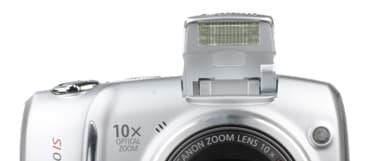
Having a manually raised flash stops it from firing when you don't want it.
**
Lens**(8.50)
The SX110 is part compact point-and-shoot, and part ultra-zoom. It doesn't quite have the mammoth zoom of some of the latter models, but is slightly smaller. For its size, 10x zoom is quite impressive, allowing you to get tightly framed shots while still quite a distance from the action. The actual zoom lens measurement is 6mm to 60mm, the 35mm equivalent of 36mm to 360mm. There is, of course, a digital zoom option, for up to an additional 4x, though we routinely counsel against resorting to this image-quality-destroying function. The aperture range afforded by the lens is f/2.8 to f/8 fully zoomed out, which shrinks to f/4.3 to f/9 at max zoom. F/2.8 is quite fast, and will let in plenty of light, so you can user faster shutter speeds and lower ISOs. The Canon has an optical image stabilization system that can be set to be on continuously, only while half pressing the shutter button, for panning (only cancels vertical shake), or off completely.
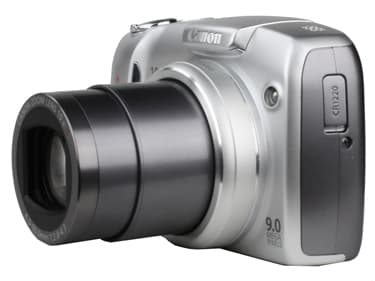
The fully extended lens.

1x, 5x and 10x zoom
Design / Layout
Model Design / Appearance*(6.00)*
The Canon PowerShot SX110 IS feels a bit like something out of Fisher-Price, but not in a bad way. It's a bit big, a bit clunky, kinda bulky. But at the same time, it feels resilient, like you might be able to kick it down the stairs and have it come out fine (but please don't try). It's not particularly beautiful, and it won't win any style contests, but it feels like it'll last, and that's important.
Size / Portability*(7.00)*
The camera is 4.34 inches wide, 2.77 inches high and 1.76 inches deep (11.06cm wide, 7.02cm high and 4.45cm deep) with the lens fully retracted, and weighs 8.64oz (245g). As we said above, it's a bit big, but it's light enough that the weight won't be a problem. It's not going to fit in your pants pocket, that's for sure, but it will in a coat or bag very easily.
Handling Ability(7.00)
For all its size, the SX110 is pretty easy to handle. It's large enough that you have plenty to grip onto, and you don't feel like a stray breeze will unceremoniously rip it from your hands, but it's also not so heavy that you'll have any trouble lugging it around.
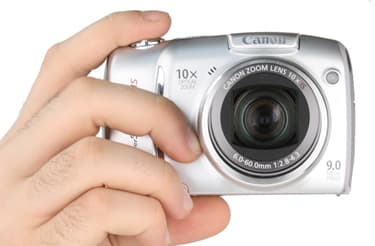
*
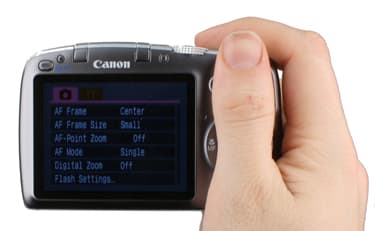
- The SX110 IS's size makes it easy to handle.
**Control Button / Dial Positioning / Size ***(9.75)*
The controls are all placed extremely well on the PowerShot. The mode dial on the camera's top adjusts with a satisfying click, yet is easy to rotate. The zoom controls feel accurate, as do the four buttons above and below the control dial. This dial is the feature that's really sold us on this camera. It functions in a similar manner to an iPod's clickwheel. You can either rotate it to scroll through settings, or press in one of the four cardinal directions to use it like a four-way pad. The controls are large enough that you never feel cramped, and they all have distinct shapes, so you probably won't press the wrong one by accident. Pressing the Playback button with the camera off will power it up without extending the lens, an efficient solution for eager image browsers. It doesn't save much time, but it's enough that you can appreciate it. Since the button is slightly recessed, it's not likely to be hit accidentally either.
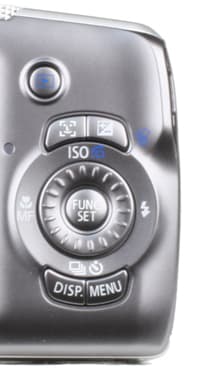
Using the control wheel makes menu browsing easy.
Menu*(6.50)*
Canon cameras usually have a series of tabs for each group of settings, each with a single page of choices to avoid time-consuming scrolling to reach additional choices. For the SX110, Canon uses uncharacteristically lengthy menus, since the control dial lets you zip through the menus incredibly fast, and saves you from the frustration usually associated with this style of menu.
The Function menu is a quick menu accessed by pressing the Func. Set button, providing quick access to some of the most commonly used options on the camera such as white balance, metering and image size.

Record menu has most of the other photography related settings. This is where you go to fiddle with focus types, digital zoom and flash settings.

Set Up has the slightly boring but important choices. Power saving, date and time, energy saving, file naming conventions and the like.

Play menu lets you edit, erase and transfer files, and is also where you set up slideshows. Unsurprisingly, it's only available while in Playback mode.
Print is another menu only accessible while in Playback mode, this single page of options is devoted to selecting the number of prints you want for each image when using direct print order forms (DPOF).

Ease of Use (7.00)
The PowerShot SX110 IS is actually very easy to use. For complete beginners there's an Easy mode, which takes all the control from your hands, and then on to Automatic, Program or Manual if you know what you're doing. All the buttons are clearly labeled with easily identified icons, the menu is laid out logically, and the controls are precise. This really is a camera that can be given to almost anyone, and regardless of their level of knowledge, they'll be able to use it.
Modes
Auto Mode*(9.00)*
There are two levels of automatic mode on the Canon PowerShot SX110 IS. The first is Easy mode, which removes almost all user control. Once you're in this mode, you can zoom, and use the flash, but that's it. Interestingly, if you flip over to Playback while in Easy, you're also given an easy playback mode, where you can look through your photos, zoom, delete and start a slideshow. If you want a smidgen more control, you can flip over to Auto, which lets you change a few more settings. You can alter the type of auto ISO (normal or high, the latter of which limits the auto ISO to an unspecified higher setting). You also control burst, focus mode (normal or macro), face detection and image quality. Then you can move onto Program mode, Shutter priority (Tv), Aperture priority (Av) or full Manual control, based on your skills and desires**.**
**Movie Mode ***(7.75)*
Movies can be shoot at three different resolutions: 640x480, 320x240 and the absolutely tiny 160x120. Videos can last up to one hour or 4GB in the larger two formats, whichever comes first. 160x120 mode can only shoot up to three minutes. If you ever want to record absolutely tiny clips, for a minimal length of time, maybe you'll find some joy here.
While recording video, the optical zoom is disabled, most likely due to the whirring of the servos, which would be quite loud once recorded. You have access to a few other controls: focus can be set to normal, macro or manual. You can set a self timer to delay the start of video recording. Full white balance controls are available in movie mode, as are color settings. Pressing the ISO button brings up a small slider on screen, which is used to adjust the scene brightness.
Drive / Burst Mode*(9.00)*
The Canon offers quite a decent variety of burst modes and timers. You have single shot, continuous (1.2 frames per second), and continuous autofocus (which refocuses for every shot, and takes 0.7 frames per second). We especially liked the ability to customize the timer. You can use the traditional 10- or 2-second timer, but you can also set up one to your own specifications, with a delay of 1-30 seconds, and it can take 1-10 shots. This is an unusually flexible arrangement that could prove useful in a varety of shooting situations. **
**
**Playback Mode ***(8.00)*
Pressing DISP while in Playback mode change sthe screen's information display. You can view just the picture; date and time the shot was taken; all shooting details, brightness histogram and over exposed areas highlighted; and finally focus check, which enlarges the center of the image so you can see if you have your photo is tack sharp. Zooming in provides up to 10x magnification, at which point you can use the scroll wheel to switch between images at the same level of enlargement. Zooming out takes you to a thumbnail view of nine images at a time, and zooming out again lets you go through pages of nine images per page.
If you're looking at an image at normal magnification, rotating the wheel will jump thtake you to a list of all the stored pictures sorted by date. If you press up on the wheel, you can scroll through images on a number of criteria: shot date, jump 100 images, jump 10 images, jump to movie or jump to folder.
Pictures will also auto-rotate if you tilt the camera 90° in either direction.
Custom Image Presets*(6.83)*
Five of the image presets are located on the mode dial itself, and a sixth scene mode setting lets you choose from additional options. The list of choices isn't shockingly huge, but it should cover most eventualities. On the dial are portrait, landscape, night snapshot, kids and pets, and indoor mode. If you flip over to Scene Mode, you can use ISO 3200 (at reduced resolution), night scene, sunset, foliage, snow, beach, fireworks or aquarium. This last one is represented by a fish, but please don't think this camera is waterproof, because it isn't.
Control Options
Manual Control Options
It does our hearts good, here at digitalcamerainfo.com, to play with an inexpensive camera that has this depth of manual control. There's a full set of manual, priority and program modes, exposure compensation and manual white balance for shooting under unusual lighting conditions. If you want to customize the camera, you can alter the timers and a button on the camera's top left. This button can be set to alter white balance; manually white balance; red-eye correction; digital tele-converter (uses minmal digital zooming instead of optical to enable higher shutter speeds and prevent the aperture from decreasing too much); display overlay (which adds a grid to help with alignment); or display off. There are a few additional featureswe would like to have seen, such as auto-bracketing or a histogram display while shooting, but all in all the XS110 IS provides an exceptionally wide and deep level of user control. **
**
Focus
Auto Focus*(7.00)*
The auto focus seemed quick to lock in generally, though it was a bit inaccurate while using facial detection. There is an auto focus assist setting that blows up the focal area so you can see just how well the camera is doing at focusing in on the important bits.
Manual Focus*(5.00)*
Manual focus is a choice here, with an additional MF Safety mode as well, where you can manually focus roughly, and then half-press the shutter and let the camera get the final touch. Once again, having a control wheel proves its worth, as spinning the wheel lets you quickly change the focus. As with auto focus, there's an assist mode to enlarge the focal area for fine detail
ISO*(7.50)*
The PowerShot SX110 IS has a respectable range of ISOs for you to play with. At full resolution you can go from ISO 80 to ISO 1600, as well as Auto and Auto Hi (the latter of which keeps the ISO in the upper reaches of the possible ISOs). If you're willing to take a resolution hit, you can also shoot at ISO 3200, but only at 2 megapixels (1600x1200). Our only significant complaint when it comes to the ISO range is high image noise at ISO 1600.
White Balance*(5.50)*
The white balance selection is average; there definitely could have been more choices. You can select auto, day light, cloudy, tungsten, fluorescent, fluorescent H or custom. Additional presets for shade and flash would have been appreciated, but the presets will do for most situations, and custom white balance, which lets you set the white balance yourself off a white or grey card, is particularly welcome to compensate for the camera's poor testing results in auto and manual preset modes.
Exposure*(8.00)*
Exposure compensation runs the standard range of ±2 EV in 1/3 steps. If you're shooting in manual mode, the SX110 IS will show a little graph on the right of the screen that shows the exposure as ±2 in 1/3 steps, so you can accurately visualize what your settings will do to your photographs.
Metering*(7.50)*
The metering can be set to spot, center-weighted average or evaluative (which uses the entire frame), once again a fairly standard run of settings. Be aware, though, that this is one of the few settings that will reset when you power down and power up again.
Shutter Speed*(8.00)*
Shutter speed runs from 15 seconds to 1/2500 of a second while in Tv (shutter priority mode). This is an excellent range, and marks the SX110 IS as a great choice if you're interested in playing with long-exposure photography.
**Aperture ***(6.00)*
In aperture priority mode, you can manually set the aperture range from f/2.8 to f/8.0 at the widest zoom setting, and f/4.3 to f/8.0 at maximum telephoto. It's not a blisteringly fast lens, but it's pretty good for its size. Just be aware that the substantial drop-off as you increase the zoom means that a tripod is a good idea for shooting distant subjects.
Image Parameters
Picture Quality / Size Options*(7.50)*
JPEG image compression can be set to superfine, fine or normal for all resolution settings, which include:
Picture Effects Mode*(7.00)*
The PowerShot SX110 IS has a function called 'My Colors' that offers settings for vivid, neutral, sepia, black and white, and custom (which lets you tweak contrast, sharpness and saturation). By default, My Colors is set to 'off.'
There are no fancy editing effects available in Playback, but you can tag your photos with category labels for people, scenery, events, category 1-3 or to do list.
Connectivity / Extras
Connectivity
Software*(8.00)*
The included Canon software does a relatively good job handling relatively basic image tasks, both in terms of image browsing and simple editing. You can tweak sharpness, brightness, red-eye, and other standard features. However, in doing so, it had a tendency to work slowly handling relatively basic tasks, and just generally felt bloated. There's also a bundled photo stitcher, and a remote control application for the camera, the latter of which is decidedly unusual. This remote application lets you hook up your camera via USB to your computer, and see on your screen what the camera sees, as well as remotely take photographs. It's very good for if you have a very sensitive setup, where you don't want to risk nudging the camera.
Jacks, ports, plugs*(3.00)*
On the right side of the camera are two ports, reasonably well protected by a cover. These are the plugs for the AV/USB cable, and the DC in plug. The former looks to be an industry standard, which means it's easy to find a spare or replace a lost cable. The DC input connects to an optional plug-in power adapter you can purchase if you find yourself burning through AAs too quickly.
Direct Print Options*(4.00)*
The Canon SX110 IS handles both major direct print options: DPOF (direct print order forms) and PictBridge. DPOF lets you tag your photos with the number of prints you want, whether you want the date and time printed on them, and whether you want a contact sheet, then hand your memory card to a print professional to follow your digital instructions. PictBridge lets you connect your camera directly to a printer via USB and output your images without using a computer.
Battery*(4.00)*
The PowerShot uses AA batteries, available at every corner store and market from here to Siam Reap. It does relatively well on them; we're onto our third set of batteries after about a week of heavy testing. On the left side of the camera is a small port, which is best left alone. This is actually the entrance way to the internal battery, which keeps track of dates, times and other such useful settings. It's quite easy to get at, if you need to replace the battery, but also easy to open accidentally.
Memory*(4.00)*
This camera accepts SD, SDHC and MMC cards, which are the de facto standard for point-and-shoot cameras. They offer large capacity at a low price, and can be found easily.
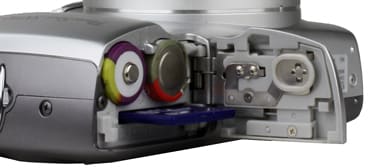
The SX110 IS takes batteries and memory cards that are both easy to find
Overall Impressions
Value*(8.00)*
For $250, you get a camera with a full suite of manual controls, a solid 10x zoom, a bit of customizability, and solid, if not amazing, test scores. It's quite a multi-purpose camera, and will just as easily shoot at a party as it will taking a photo of a bird on a nature walk. It straddles the line between ultra-zoom and compact point-and-shoot. It has most of the zoom and controls of the former, but the more portable size of the latter, and strikes as a good flexible camera that can be chucked in a bag for just about any situation.
Comparisons
[

](https://www.reviewed.com/cameras/content/Canon-PowerShot-SX100-IS-Digital-Camera-Review-16125.htm)
**Canon PowerShot SX100 IS – **The predecessor model to the SX110 IS, this is a slightly less expensive alternative at present, as you can find one for approximately $200. The older model generally performed ever so slightly worse in our lab testing, except on white balance and low light, where it did markedly better. It shoots at slightly lower resolution than the SX110 (8 megapixel instead of 9), but it's a solid alternative if you're pinching pennies.
[

***Casio Exilim EX-FH20***** – **The Exilim FH20 is an ultra-zoom like the SX110, but its primary claim to fame is its ludicrously high speed. It will set you back $600, but can shoot 40 photos a second, at full 7-megapixel resolution, and up to 1000 fps super-slow-motion video. If you're really keen to catch the perfectly timed shot, and can part with the money, the FH20 is worth considering.
[

](https://www.reviewed.com/cameras/content/Panasonic-Lumix-DMC-FZ18-Digital-Camera-Review-16104.htm)
Panasonic Lumix DMC-FZ18**–**The FZ18 is currently our highest scoring ultra-zoom. It shoots eight megapixels to the Canon's nine, and costs around $300. With that you get an increased 18x zoom (and consequential larger body size), and better test scores for resolution, dynamic range and noise. If you're looking for a camera with a larger zoom and a more SLR-like body, this is one of the finest cameras we've reviewed (even if it does cost slightly more).
[

](https://www.reviewed.com/cameras/content/Sony-Cyber-shot-DSC-H7-Digital-Camera-Review-13152.htm)
Sony Cyber-Shot DSC-H7**–**Another highly rated ultra-zoom, this time with a 15x zoom, and eight-megapixel resolution. Going for about $375, the Sony scored extraordinarily wel for noise and dynamic range, making it quite appealing for low-light photography. It didn't do quite as well for video or color, but if you think you'll be photographing in challenging lightin situations and don't mind the extra size, it's worth a closer look.
**
Who It’s For ***
Point-and-Shooters* – With an Easy mode for complete beginners, and Auto for those with a smidgen more confidence, it takes almost no photographic experience to use the SX110 IS successfully. And if you feel the urge to take more control of your photographic process, it's straightforward to segue into more advanced settings, like program mode.
Budget Consumers – If cash is especially tight, the SX100 IS is marginally less expensive, but $250 for the SX110 IS is a good deal too. Either option is easy on the pocketbook, and they're both decent cameras.
Gadget Freaks – Gadget lovers won't find much to admire with the bulky and slightly clunky PowerShot. While it is a good all-around camera, it's probably not sleek or sexy enough for a technology fiend, nor does it have any ultra-cool features.
Manual Control Freaks – Control freaks will appreciate the depth of manual controls that the SX110IS provides. Full manual mode, aperture priority, shutter priority, custom white balancing and some degree of control customizability are all here. There could be a few more white balance settings, or maybe auto exposure bracketing, but for a point-and-shoot camera, this is a fairly full set of controls.
Pros / Serious Hobbyists – As a backup camera that can just be thrown into a bag, but still packs enough controls to satiate a pro-user and a decent zoom, the SX110 definitely has appeal. However, the poor test results will probably end up turning them away from the camera.
Conclusion
**
Conclusion**

It's big, clunky, and didn't score particularly well in our testing, but the Canon PowerShot SX110 IS has it's own particular brand of charm. The settings are a cinch to navigate due to the excellent control scheme and well designed menu system. The body feels large, but well proportioned, and all the buttons are big and uniquely shaped so that you won't hit the wrong one. It has a decent 10x zoom, good color and video scores, and costs a reasonable $250. It's not the smallest, fastest or prettiest camera that we've ever used, but we like it.
Sample Photos
**Sample Photos
Click on any of the images below to view the full-sized original image. However, please note that the image files are extremely large and could take a long time to download. **
**
You can find photos taken on the SX110 on the following sites******
[

](http://search.fotki.com/?q=SX110)[

](http://www.smugmug.com/search/index.mg?searchWords=SX110&searchType=global&x=0&y=0)****
Specs / Ratings
**Specs Table
**{{manufacturer_specs_table}}{{raw_scores_table}}
Meet the tester
Tim Barribeau is a valued contributor to the Reviewed.com family of sites.
Checking our work.
Our team is here to help you buy the best stuff and love what you own. Our writers, editors, and experts obsess over the products we cover to make sure you're confident and satisfied. Have a different opinion about something we recommend? Email us and we'll compare notes.
Shoot us an email